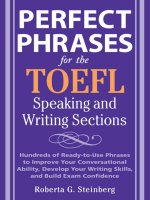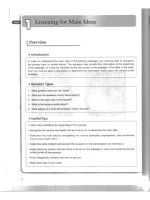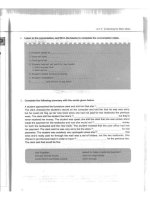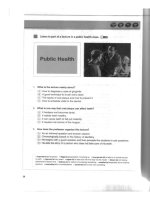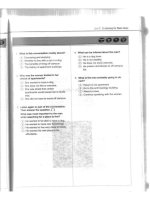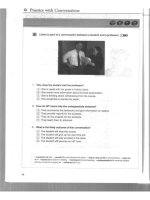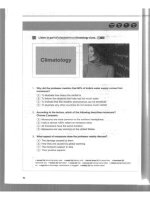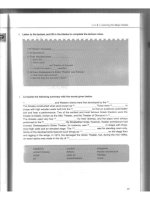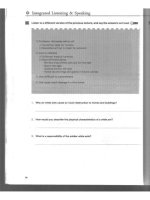english for the toefl test listening speaking
Bạn đang xem bản rút gọn của tài liệu. Xem và tải ngay bản đầy đủ của tài liệu tại đây (37.71 MB, 225 trang )
Collins
English for Exams
www.frenglish.ru
Be prepared
for all question types
Learn
useful tips and strategies
Boost
your vocabulary
Increase
your fluency and accuracy
Build
your confidence
Improve
your score!
SKILLS FOR THE
TOEFL iBT® TEST
Listening and Speaking
www.frenglish.ru
Collins
English for Exams
SKILLS FOR THE
TOEFL iBT® TEST
Listening and Speaking
www.frenglish.ru
Collins
HarperCollins Publishers
77-85 Fulham Palace Road
Hammersmith
London W6 SIB
First edition 2012
Reprint 10 9 8 7 6 5 4 3 21 0
Reprinted 2013
HarperCollins Publishers 2012
ISBN 978-0-00-746060-1
Collins • is a registered trademark of HarperCollins Publishers Limited.
svww.collinselt.com
A catalogue record for this book is available from the British Library.
Editorial Services: ContentEd Publishing Solutions, L.LC
Writing Services: Creative Content, LLC
Typeset in India by Aptara
Printed in Italy by Lego
All rights reserved. No part of this book may be reproduced, stored in a
retrieval system, or transmitted in any form or by any means, electronic,
mechanical, photocopying, recording or otherwise, without the prior
permission in writing of the Publisher. This book is sold subject to
the conditions that it shall not, by way of trade or otherwise, be lent.
re-sold, hired out or otherwise circulated without the Publisher's prior
consent in any form of binding or cover other than that in which it is
published and without a similar condition including this condition
being imposed on the subsequent purchaser.
HarperCollins does not warrant that www.collinselt.com or any
other website mentioned in this title will be provided uninterrupted,
that any website will be error free, that defects will be corrected, or
that the website or the server that makes it available are free of viruses
or bugs. For hill terms and conditions please refer to the site terms
provided on the website.
Academic Word List 0 Cordread, Averil 2000
www.frenglish.ru
Contents
How to Use This Book
Overview of the TOEFIY Test
Guide to Listening
Overview
Challenges and Solutions
Lesson 1:
Main Idea Questions and Detail Questions
Lesson 1k Main Idea Question Overview
Walk Through
Get It Right: Tips and Tasks for Answering Correctly
Lesson 1B: Detail Question Overview
Walk Through
Get It Right: fins and Tasks for Answering Correctly
13
Progressive Practice
Lesson 2:
Purpose Questions and Inference Questions
Lesson 2k Purpose Question Overview
Walk Through
Get It Right: Tips and Tasks for Answering Correctly
Lesson 2B: Inference Question Overview
Walk Through
Get It Right: Tips and Tasks for Answering Correctly
24
Progressive Practice
Lesson 3:
Function Questions and Attitude Questions
Lesson 3k Function Question Overview
Walk Through
Get It Right: Tips and Tasks for Answering Correctly
Lesson 3B: Attitude Question Overview
Walk Through
Get It Right: Tips and Tasks for Answering Correctly
36
Progressive Practice
Lesson 4:
Organization Questions and Connecting Content Questions
Lesson 4A: Organization Question Overview
Walk Through
Get it Right: lips and Tasks for Answering Coned&
Lesson 4B: Connecting Content Question OVENView
Walk Through
Get It Right: Tips and Tasks for Answering Correctly
48
Progressive Practice
Listening Review Test
59
III
www.frenglish.ru
Guide to Speaking
73
Overview
Challenges and Solutions
Independent Questions
Lesson 1:
Personal Experience Question Overview
Walk Through
Get It Right: 'lips and Tasks for Answering Correctly
as
Progressive Practice
Lesson 2:
Paired Choice Question Overview
Walk Through
Get It Right: Tips and Tasks for Answering Correctly
96
Progressive Practice
Integrated Questions
Lesson 3:
Campus Matters Question Overview
106
Walk Through
Get It Right: Tips and Tasks for Answering Correctly
Progressive Practice
Lesson 4:
Academic Reading and Lecture Question Overview
Walk Through
Get It Right: Tips and Tasks for Answering Correctly
119
Progressive Practice
Lesson 5:
Campus Conversation Question Overview
Walk Through
Get It Right: Tips and Tasks for Answering Correctly
132
Progressive Practice
Lesson 6:
Academic Summary Question Overview
Walk Through
Get It Right: Tips and Tasks for Answering Correctly
144
Progressive Practice
iv
Speaking Review Test
155
Answer Key
168
Audio Scripts
Academic Word List
184
205
www.frenglish.ru
HOW TO WHO BOOK
How to Use This Book
Skills for the TOEFL MT' Test: Listening and Speaking and its companion edition, Skills for the
TOEFL iBT° Test: Reading and Writing offer a comprehensive guide to the TOEFL test. If you use
this series to prepare for the test; you can earn a top score on the TOEFL test and improve your
chances at getting accepted by your university of choice.
No matter the level of your English, Skills for the TOEFL iBr Test: Listening and Speaking provides
you with all the tools you need to succeed on the test. Here's a 'glimpse of the learning tools
included in this boolc:
0
Skill-specific Challenges and Solutions sections. These sections offer strategy and skill reviews
to help you learn how to overcome the most common challenges in each section of the test.
Quick Guide question overviews. Each lesson provides a brief summary of the question type
than easy-to-read chart, making it simple for you to quickly understand what is important to
know in order to answer the question correctly.
Walk Through samples. Clear, visual examples show you the types of questions, passages, and
responses you can expect to find on the test. Knowing what to expect is an important part of
preparing for the test.
Get It Right presentations. These presentations give an overview of the most important steps
for doing well on each question. They include useful vocabulary and expressions that you can
use when answering the questions and provide tips and tasks for noticing and understanding
the important elements of each question type.
Progressive Practice. For each question type, carefully designed activities gradually prepare you
for the TOEFL test This step-by-step practice builds the knowledge and skills you need for a
high score and encourages independent learning while working up to TOEFL testing levels.
Get Ready activities require you to look and listen for certain pieces of information, practice
structured activities, and notice why answers are correct or incorrect.
Get Set activities encourage even more practice working with the question types and answers
and will help you gain the skills and confidence you need.
Go for the TOEFL Test activities provide you with authentic test questions to practice what
you have learned and further prepare you for the test.
l) Answer Analysis presentations. The answer analyses will teach you how to eliminate incorrect
answer options and select the best answers for various question types.
Skill-specific Review Test sections. At the end of each section, you'll be able to put your skills
to the test by taking a timed practice test. The review sections will help you identify your
weaknesses so you can know what areas to focus on before the test.
Test Tips. Throughout the book, you'll see Test Bps which offer best-practice strategies and
useful advice on how to approach certain activity types.
Dictionary definitions. Collins COBUILD Advanced Dictionary definitions and Web links are
provided throughout the book to help you understand words and build your knowledge of
academic vocabulary often found on the TOEFL test and in US university texts and lectures.
0 Academic
Word List. The Academic Word List, compiled by Averil Coxhead (2000), consists
of 570 word families that occur frequently over a wide range of academic texts. Knowing and
practicing these words will help you build your vocabulary base to understand and use more
academic English words.
Audio Script and Answer Key Found at the back of this book, these tools will help you practice
and check your answers as you prepare %r the TOEFL test The speaking section's answer key
and audio script indudes two sample responses and scores for each question type.
www.frenglish.ru
was FOR THE TOER IBT TEST LISTENING AND SPEA/ONG
v CDs. The CDs included with this book provide you with all of the listening passages for the
lessons and review tests. The speaking section's Go for the TOEFL Test and Review Test portions
include authentic beeps so you can practice timing your responses. You will also find sample
responses for the speaking section.
lips for Success
Make a plan to succeed, and start by following these tips:
Register early for the test. Check the application deadlines for the universities you are applying
to. Make sure that you register to take the test well before the deadline to ensure that your scores
arrive on time. For information on how to register, see page xi of this book.
)) Learn the score requirements for the universities you want to apply to. Degree programs that
have minimum score requirements typically post them on their admissions Web sites.
Start to study early. The more you practice, the more you will improve your skills. Give yourself
at least one month to review the materials and complete of the practice activities in this book
and in the companion edition, Skills for the TOEFL iBT1 Test: Reading and Writing. Spend at least
one hour a day studying, and don't give up. Remember, by using this book, you are on your way
to high scores on the TOEFL test!
a
Time yourself when you complete the exercises and practice tests in this book and in the
companion book, Skills for the TOEFL iBT.Test: Reading and Writing
Listen to the scripts and model responses as many times as you need to in order to understand
the concepts taught in this book.
Complete the exercises on the page. Also, don't be afraid to make your own notes on the page.
For example, writing down the definitions of words you don't know will help you remember them
later on.
))
On the listening section, try not to go back to the questions once you've completed them. This
will help you get used to the process on the actual test.
))
On the speaking section, return to the prompts and try to come up with new responses. Practice
until creating responses within the time limits becomes easy for you.
Overview of the TOEFL. Test
The TOEFL' iBT test (Test of English as a Foreign Language) measures your proficiency in English.
The TOEFL test does not evaluate your knowledge of the English language. Rather, it measures your
ability to Hal English in a variety of academic settings.
The test is divided into four timed parts: Reading, Listening, Speaking, and Writing. Each section
tests key skills that you will need in order to succeed as a student at an English-speaking university.
Reading Section
The reading section is the first section on the test. It measures your reading comprehension abilities
by presenting you with a series of academic passages. Then, you will answer a set of questions based
on each reading. The questions in this section test your ability to:
identify the main idea.
understand the main details.
make inferences.
understand the organizational structure of the passage.
use context dues to determine the definitions of key words.
vi
www.frenglish.ru
HOW 70 USE NM BOOK
There are three-five academic reading passages per reading section. Each passage is between
600 and 750 words long. After each reading passage, you will answer a set of questions. There
are usually 12-14 questions per passage. In the reading section, you are allowed to go back
to previously answered questions in the section to review or change your answers. For more
information on the reading sections, see Skills for the TOEFL iBT• Test, Reading and Writing.
TOEFL Reading
110'1;7) arri Ern
Question 1 oil2
I. Based on the information in paragraph I, what can be
inferred shoot Darwin's theory of moon formation?
0 It was the first theory of moon formation to gam wide
acceptume.
0 It assumed that the Earth and moon were made of the
same material.
0 It was inspired by other scientists' work on the
condensation theory.
0 It explained why the Earth and the moon developed at
different times.
Paragraph 1 is marked with an arrow 14]
a no is 58
Origins of the Moon
4 Throughout the 59th and 20th centuries, several
astronomers advanced competing theories about how
the moon formed. For example, in 1878, astronomer
George Howard Darwin proposed fission theory, which
claimed that early in the Earth's formation, the planet
began spinning extremely fast. Darwin believed that the
rapid spinning motion caused a large chunk of Earth to
break off and launch into space This chunk then began
orbiting the Earth and became the moon. Another
explanation. called the condensation theory, stated that
while the solar system was still forming, a star exploded
and left behind mass amounts of debris. According to
condensation theory, the Earth and the moon formed
rougldy at the same time, and through the same
processes, from this debris.
Listening Section
The listening section is the second section on the test. In order to evaluate your listening
comprehension abilities, you will first listen to a lecture or conversation through your headphones.
Then, you will answer a set of questions based on each listening. The questions in this section will
test your ability to:
D
identify the main idea or purpose of the listening.
understand the main details.
make inferences.
4 identify the speaker's purpose.
There are six-nine listening passages per listening section. Each listening is between five and
seven minutes long. After each listening passage, you will answer a set of questions. There are
usually five-six questions per passage. In the listening section, you are nat allowed to review
questions that you have answered previously.
vii
www.frenglish.ru
SKILLS FOR THE TOEFL IBT TEST USTENING MD SPEAKING
Speaking Section
The speaking section is the third section on the test. In this section, you will speak into the
microphone your responses to a variety of tasks The tasks test a number of speaking abilities,
induding:
g giving opinions.
a understanding and responding to questions in the dassroom.
a participating in discussions on academic subjects.
a synthesizing (combining) information from two sources.
a reporting the opinions of others.
a interacting with university employees.
There are six speaking tasks in the speaking section: two independent tasks and four integrated tasks.
Each item requires different skills, including reading, listening and speaking, and speaking only.
TOEFL Speaking
c
o
o
Describe an activity that you like to do and explain why you like doing it. Please include specific
details in your explanation.
Preparation Time: 15 Seconds
Response Time: 45 Seconds
vfil
www.frenglish.ru
HOW TO USE THIS BOOK
Writing Section
The writing section is the fourth section on the test. In this section, you will type on the computer
your responses for each item. The tasks measure your ability to:
)) plan and organize an essay.
o
develop a written response by using examples or specific details.
>) use a variety of grammatical structures and vocabulary.
)) use correct spelling and punctuation.
There are two writing tasks in the writing section: one integrated writing task and one independent
writing task. For more information on the writing section, see Skills for the TOEFL iffr Test,
Reading and Writing.
TOEFL Writing
Question 2 or 2
Directions Read the question below. You have 30 minute to prepare,
mite and revise your response. An effective response ustialty contains
at least 300 words.
alfalfa.
Question:
Do you agree or disagree with the following statement?
It is necessary to be competitive in order to succeed in life.
Use specific reasons and examples to support your response.
Experimental Sections
In order to field-test new materials, ETS always includes an experimental section in either the
reading or listening section of each test. That means that on the day of the test, you will see extra
passages and questions in either the reading section or the listening section. If the experimental
•
section is part of the reading section, you will have to read an additional two passages and answer
the accompanying questions for them. If the experimental section is part of the listening section,
you will have to listen to an additional three listening passages (two lectures and one conversation)
and answer questions that are based on them.
Please note that the experimental section is not graded. However, you will have no way of
knowing which section is experimental, so it is very important that you try your best on all sections
of the test.
lx
www.frenglish.ru
SELLS FOR INE TOER SUET L6TENING AND SPEAKING
QUICK GUIDE: TOEFL- Test
Section
Reading
Section
Tasks
Timing
Part 1 (1 Passage + Questions)
20 minutes
Number of Questions:
Part 2 (2 Passages + Questions)
40 minutes
39-70
Part 3* (2 Passages + Questions)
40 minutes ,
Reading Passages. 3-5
Total Section Time: 60-100 minutes
Listening
Section
Listening Passages: 6-9
Part 1 (2 Lectures, 1 Conversation + Questions)
4-6 Lectures
30 minutes
Part 2 (2 Lectures, 1 Conversation + Questions)
2-3 Conversations
30 minutes
Number of Questions:
Part 3* (2 Lectures, 1 Conversation + Questions)
34-51
30 minutes
Total Section Time: 60-90 minutes
10-Minute Break
Speaking
Section
Number of Questions: 6
2 Independent
Total Section Time: 20 minutes
4 Integrated
Writing
Section
Number of Tasks: 2
1 Integrated
1 Independent
Integrated Task:
20 minutes
Independent Task:
30 minutes
Total Section Time: 50 minutes
*These parts are experimental and will appear on either the reading or the listening section.
Scoring
You will receive a score for each section of the test. The score ranges per section are as follows:
Reading
0-30
Listening
0-30
Speaking
0-30
Writing
0-30
In order to calculate your total score, the individual scores for the four sections are added together.
Thus, the highest score you can possibly achieve on the TOEFL test is 120.
The reading and listening sections are both scored by computer. However, in order to determine
your scores for the speaking and writing sections, your responses are saved and sent to ETS, where
they are scored by certified raters. Each of the six responses in the speaking section is assigned a
score of 0-4. The scores for each task are added together and converted into a score on the 30-point
scale described above. Similarly, the two tasks on the writing section are each given a score of 0-5.
Again, the scores for both tasks are added together and then converted to a score between 0 and 30.
X
www.frenglish.ru
HOW TO USE 110 8001(
Score Reports
There are several ways to review your scores. First, you may view your scores online 15 business
days after the test. All you have to do is visit the TOEFL Web site at www.ets.org/toefl and sign
in to the "My TOEFL iBT account" with the username and password that you created when you
registered for the test. Your online score report will show the following information:
" The date that you took the test
D Your scores for each section
D
Your total score
Performance evaluations for each section that describe whether your performance was low,
medium, or high
You may access your scores online for tests that you have taken within the past two years. Please
note that the universities and / or institutions that you have selected to receive your scores will also
be able to view your scores online.
In addition to being able to access your scores online, you will receive a paper score report via mail
two to three weeks after the test date.
TOEFL Test: What You'll See and Hear on the Day of the Test
Registration
There are a number of ways to register for the TOEFL iBT test.
Online Registration: Visit the TOEFL Web site at www.ets.org/toefl and follow the instructions
for registering. On the Web site, you will be able to find the nearest test center and dates for
upcoming tests. Seats at test centers are limited, so be sure to register for the test early! You must
register seven days before your desired test date. Late registration is also available up to three days
before your desired test date, but you will be charged a late-registration fee.
By Phone: Visit the TOEFL Web site and download the registration form. Then, call your
regional registration center (check the Web site for phone numbers) and a representative will
help you register. Late registration by phone is available until 5 p.m. the day before your desired
test date.
By Mail: Visit the TOEFL Web site and download, print, and complete the registration form.
Send your completed form with payment to your regional registration center at least four weeks
before the desired test date.
For payment information and other details about the registration process, visit the TOEFL Web site
at www.ets.org/toefl.
Before the Test Starts
When you arrive at the test center, you will sign in and give your identification document, such as
a passport, to a test-center employee (for information about accepted identification documents,
see the ETS Web site at www.ets.org). Make sure that the name on your identification document
matches the name under which you registered! If it does not match, you will not be allowed to take
the test
After you sign in, the employee at the test center will instruct you to put your personal belongings,
such as your jacket, car keys, or cell phone, into a storage area. Review the TOEFL Web site for
rules about personal items. You will also be Oven a document that outlines the rules of the test. At
the end of the document, you will see a statement of confidentiality. You are required to write this
statement at the bottom of the page. Then, you will sign and date the document and submit it to the
employee.
xi
www.frenglish.ru
SKILLS FOR FIE TOER IBT TEST LISTENING AND SPEAKING
Next, an employee at the test center will call your name. You will be asked to pose for a photograph
in order to ensure that you are the person who signed up to take the test (this photo will appear
on the paper copy of your score report). At this point, the employee will return your identification
document. The employee will also give you two pencils and several sheets of blank paper for notes.
You may be asked to show the employee the insides of your pockets to verify that you are not taking
any unauthorized materials into the test room. Then, an employee will escort you to the computer
on which you will be taking the test
Screen-by-Screen Prorpqs
Confirmation of Identity: On the first screen, you will see your name and the photo taken of
you before you entered the test room. Before you proceed, you must confirm that the information
is correct.
Copyright Screen: The next screen contains copyright information about the TOEFL test
materials. To proceed, click "Continue:'
Test Introduction: You will see a screen that contains general information about the test,
including:
a general description of the TOEFL test
a short description of all four parts of the test.
timing guidelines.
Once you have finished reading the introduction, click "Continue" to proceed to the next screen.
Test Rules: The next screen will describe the test policies. Be sure that you read the rules
carefully and that you understand them, as breaking any of the rules may result in cancellation of
your scores and the loss of your test fee. Click "Continue" when you've read and understood the
rules.
Confidentiality Statement: You will see a confidentiality agreement on the next screen. The
confidentiality agreement states that you will not share information about the test, such as
passages or questions, with anyone. Read the statement carefully. By clicking 'Continue" on this
screen, you are agreeing to the terms of the confidentiality statement.
Headset Instructions: On the following screen, you will be instructed to put on your headset.
The headset includes noise-canceling headphones and a microphone. You are allowed to wear the
headset throughout the entire test.
C C
Please put on your headset at this time.
Make sure to properly position and adjust
your microphone in order to achieve a
high-quality recording. In your normal
speaking voice, speak directly into the
microphone.
kir
www.frenglish.ru
HUNTO USE THIS BOOK
7. Microphone Adjustment Next, you will see a screen that gives you instructions on how to
adjust your microphone. You will be asked to speak a response to the following sentence: Describe
the city that you live in. Please note that this portion is not graded and is used only to adjust your
microphone. Just be sure to speak dearly and in your normal speaking voice.
You will continue to speak until a window appears that says the following: Success: Your
microphone is fiinctioning properly.
If your microphone adjustment is not successful, readjust the microphone so that it is doser to
your mouth and try again. If you continue having problems adjusting your microphone, raise
your hand to get help from an employee at the test center.
Section Sc./Bens
At the beginning of each section, you will see a screen that gives you directions about that
particular section. Please note that the on-screen tools will vary according to the section. For more
information about the screen-by-screen process for each section, see the Overviews and Walkthroughs for the different question types.
On-screen Tools
Throughout the test, you will have access to a number of on-screen tools. The tools vary slightly by
section. For example, in the reading section, you will have a button that allows you to review your
answers. In the listening section, you will have buttons that allow you to confirm your answers
before you proceed. For more information about the specific on-screen tools, please see the
Overview for each section.
"Help" Button
During the reading and listening sections, you will see a "Help" button on the toolbar at the top of
the screen. By clicking on the "Help" button, you will be given:
instructions for using the on-screen tools.
instructions for marking your answers.
section directions.
test directions.
Please note that when you access the "Help" materials, the dock will keep running. If you must
refer to these materials, be sure to do so quickly or you may waste precious time.
About the Break
After you've finished with the listening section, you are required to take a 10-minute break The
break screen will appear on the monitor. At this time, you may leave the test room. You will have
to take your identification document with you. When you leave the test mom, be sure to notify the
test-center employee. You may be required to sign out diking the break.
When you are ready to return to the test room, you will have to show the test-center employee
the contents of your pockets once again. You may also have to sign back in. Then, the test-center
employee will escort you back to your seat and unlock the screen so you can continue the test.
Please note that while you are allowed to use the bathroom at any point during the test, the dock
will not stop unless it is your designated break time. Therefore, to ensure that you have enough time
to finish each section, it is wise to leave the test room only during the break.
www.frenglish.ru
SKILLS FOR THE TOER rEST
USTENING AND SPEAKING
When You're Done
Score Reporting: After you've completed the final task of the writing section, you will see the
score-reporting screen, which will give you the option of reporting or canceling your scores. If
you choose to cancel the scores, you will not be able to see your scores. Furthermore, you will not
receive a refund of the test fee.
6-acr'
Mr TIME
fl[
'-U
Report or Cancel Scores
At this time, please decide whether you would like to report or cancel your
scores from this testing session.
Checking Out: When you are finished, you may leave the test room. Be sure to bring your
notepaper, pencils, and personal identification document. The test-center employee will take back
the pencils and notepaper. You will sign out and indicate the time that you finished the test. Then,
you can get your personal belongings from the storage area and leave the test center.
xlv
aigkaisk
www.frenglish.ru
Overview of the Listening Section
The listening section is the second part of the TOEFL test. It tes s your ability to
understand spoken English by presenting you with a series of listening passages
and then asking you a set of questions based on each listening passage.
QUICK GUIDE: TOEFL® Test Listening Section
Definition
The listening section tests your comprehension of English lectures and conversations.
The section includes different types of listening passages spoken by native speakers.
Some passages are ahni it academic topics, while others are about experiences that
a student may encounter on campus.
Targeted
Skills
In order to do well on the listening section, you must be able to:
understand basic academic vocabulary.
identify a speaker's meaning based on intonation and tone.
take good notes.
answer questions within the given time (for more information about question
types, see page 13).
The
Listening
Passages
The listening section includes between six and nine listening passages. A typical
listening section consists of sbr listening passages, which you hear through your
headset. (Please note that, on some occasions, the testing company EIS will
Include three additional pieces of sample material. This sample material is not
scored. However, since you will not know which passages are sample materials,
you should try your best on all of the passages.)
There are three different types of passages in the listening section: academic
lectures, office hours conversations, and service encounter conversations (for
more information about passage types, see pages 4-5). Each passage is between
three and seven minutes long, and you will hear each passage only once.
Questions
There are five or six questions per listening passage. After an academic lecture,
you will answer sbr questions. After office hours and service conversations, you
will answer five questions. The questions usually fall into the following categories:
Main Idea
• Function
Detail
• Attitude
Purpose
• Organization
• Connecting content
Inference
Timing
You will have 20 minutes to answer the questions for a set of six listening
passages; however, the clock will not run while you are listening to the passages.
In other words, no time will be deducted while you are listening to the lectures /
conversations. The entire section, including listening time, takes approximately
60-90 minutes to complete.
www.frenglish.ru
Listening Section: What You'll See and Hear
On-Screen Tools
In the listening section, the information on the computer screen is slightly different than in other
parts of the test. Study the sample screen below to familiarize yourself with the on-screen tools for
the listening section.
(I)
Question 1 of 34
indicates what section of the test you are
currently working on
shows how many of the questions you
have completed in the section
allows you to adjust the volume of the
listening passages. When you click on this
button, you will be able to move a slider
up or down to increase or decrease the
volume.
allows you to get important information
about the section. Keep in mind that the
dock will continue to count down if you
click on this button.
is used to confirm your answer. You will
make your answer choice on the screen
and then click on this button to proceed
to the next question (see f). Remember,
once you go to the next question, you
faxiol go back to previous questions.
is used to move on to the next question.
You cannot proceed until you have
confirmed your answer choice by clicking
on the "OK" button (see e).
allows you to hide / view the countdown
dock
shows how much time is left to answer
the questions
Screen-by-Screen Prorpes
In the listening section, you will see a number of screens. By familiarizing yourself with the screens and the
instructions, you will know exactly what to do on the day of the test.
1. Instructions: First, you will see an instruction screen that gives you general information about the
section, including the contents of the section, how much time is allotted for answering questions,
instructions for marking your answers, etc. In addition to reading the information on the screen, the
narrator will read the instructions, You must waft until the narrator has finished reading the instructions
before you are allowed to move on to the next screen.
2
www.frenglish.ru
OVERVIEW OF THE WIPING sEcnoN
Preparation screen: Once the section begins, the narrator will tell you to prepare for the listening
passage. The following message will appear on the screen: Now get ready to listen.
Listening: The lecture / conversation will start. As you listen, a picture of a university setting will appear
on your screen (the picture will vary according to passage type). A blue bar on the bottom center part
of the screen marks the progress of the passage. For example, if half of the bar is blue, the listening
passage is hail over. Use this bar to gauge how much time is left in the listening passage.
C 0 0 0
Transition to the questions: After the conversation is done, the narrator will instruct you to prepare to
answer the questions. The following message will appear on the screen: Now get ready to answer the
questions. You may use your notes to help you answer.
Questions: Then, the narrator will read the question. After the narrator has given the question, it will
appear on your screen, along with the answer options. To mark the answer, click on the circle you want
to choose. The circle will fin dark when it has been selected. To deselect a choice, click on the circle
again. You must select an answer option to continue. After selecting an answer option, click on the "OK"
button that appears at the top right part of the screen to confirm your answer. Then, click on the "Next"
button to proceed to the next question. Remember. you cannot qo back to previous Questions after you
click "Next." so be careful when using it!
Question 1 of 34
MX", CC co on
Why does the student visit the professor?
0 To ask for help on a paper
0 To request an extension for an assignment
To get information about a book
0 To explain why she missed class
3
www.frenglish.ru
Listening Sartion: Passage Types
In the listening section, there are three types of listening passages: office hours conversations, service
encounter conversations, and academic lectures. Each passage type differs in terms of content.
Office Hours Conversations Office hours conversations typically focus on topics that may come up in
a conversation between a student and a professor. In North American universities, office hours are a set
time during which professors meet with students in order to answer questions or discuss school-related
matters.
The office hours conversations on the TOEFL test last between five and seven minutes. There is &jays at
least one office hours conversation per listening comprehension test. Topics vary and may include:
discussions of paper topics or assignments.
inquiries for more information on or clarification of a concept introduced in class.
requests for letters of recommendation or career advice.
Service Encounters Meanwhile, service encounter conversations deal with issues that a student at
a North American university may experience in a number of on-campus situations. Service encounter
passages are conversations that occur between a university student and an employee of the university. The
employee may work in any of the following departments:
housing
student life
registrar
financial aid
• campus security
• career services
• library
The service encounter conversations on the TOEFL test last between five and seven minutes. There
is always at least one service encounter conversation per TOEFL test. The topics of service encounter
conversations are not academic; rather, they deal with issues that a student may experience while at a
university. Sample topics of service encounter passages include:
getting a new roommate
joining a club
adding or dropping a class
learning about scholarships
• reporting a lost item
• advice for finding an on-campus job
• reserving a book at the library
Academic Lectures Finally, academic lectures focus on academic topics that draw from a variety of
academic subjects. These listening passages are similar to lectures given by professors that students
might encounter in university classrooms. The topics for academic lectures are drawn from a wide range of
academic subjects, including:
anthropology
archaeology
art history
astronomy
botany
biology
education
engineering
environmental science
history
4
• geology
• geography
• literature
• music
• paleontology
• photography
• psychology
• sociology
• urban studies
www.frenglish.ru
OVERVIEW OF THE USTENING SECTION
There are four to six academic lectures in the listening section. The academic lectures can be further
classified into three types: professors lectures, integrated lectures, and in-class discussions. The
main distinction between each type is the amount of student interaction. See the table below for more
information on each type of academic lecture.
Professors' Lectures
Integrated Lectures
In-class Discussions
Professor talks 100% of the
time.
Professor talks 75% of the time.
Students may ask questions or
provide brief answers to the
professor's questions, but the
bulk of the content is spoken by
the professor.
Professor and two students
have roughly the same amount
of talking time. In this type
of discussion, students often
address each other in addition
to speaking to the professor.
5
www.frenglish.ru
Challenges and Solutions
* CHALLENGE 1:111 don't know a lot of the words that I hear in the audio recordings or see in the
questions."
SOLUTION: Expand your vocabulary. The TOEFL test content focuses mainly on academic contexts.
There are several word lists available that present the most common words found in academic settings.
The Academic Word List (AWL), developed by Averil Coxhead, is a list of 570 words that are commonly
included in introductory college texts. Getting to know these words will likely help you perform better on
the test and prepare for entering English-language courses.
SOLUTION: Listen for definitions when you hear a word you don't know. When a specific term is
introduced, the professor will always define the word in the lecture.
SOLUTION: Use the context, words, or phrases around unknown words in recording, questions, or
answer options to help you figure out meaning. In the listening section, speakers will often provide a
number of meaning clues for the definitions of key terms. See the table below for common ways that
speakers give context clues for key terms. To practice, try listening to English-language news programs.
Announcers often make the meaning of new terms clear by using these types of clues.
Ways of Giving Context Clues
Repetition
Rewording
The speaker will repeat a
key term several times in
the same paragraph.
The speaker will often reword a
Speakers use certain terms
phrase so that the meaning of a
to introduce a definition,
term is clearer. A rewording often including
includes the following phrases:
This refers to . . .
By that, I mean .
This means . .
What Pm talking about here
That's a . . .
I think a definition is in
In other words . . .
order here.
In order to clarify a
definition, speakers will
give examples. Listen for
the following phrases for
examples:
like
such as
you know
Example
Example
Example
Example
It a matter of agency I think
a definition is in order here
Agency is people's ability to
make choices that will influence their futures.
Engaging in recreational
aVivities such as jogging or
playi g un instrument has
been shown to reduce stress
levels.
Animals use camouflage to
Why do companies vet new hires?
protect themselves from pred- I mean, why do they perform
ators. An animal might blend background checks and check out
in with the background and the potential employee's history?
that's camouflage
Definition Signposts
Giving Examples
» CHALLENGE 2:9 get lost as I listen to lecture portions of the listening test"
SOLUTION: The lectures in the listening section of the TOEFL test are typically between five and
seven minutes long. Sometimes it's difficult to stay focused throughout the test. One way to avoid
problems with this is to learn the organizational structure of TOEFL listening passages. If you understand
how each passage is generally structured, you will be able to better predict what type of information will
be included in the lecture and where this information will appear in the lecture. If you lose concentration
while listening, you just have to think about how the passage is structured in order to get back on track.
Note that nearly all of the academic lectures in the TOEFL listening section follow one of the following
common organizational structures:
definition
• theory / support
compare and contrast
• pros and cons (advantages and disadvantages)
process
• cause and effect
classification
6
www.frenglish.ru
OVERVIEW OF THE LJSTENING SECTION
For more information about the organizational structures of listening passages, see page 52. To practice,
try listening to some of the lectures on the audio for this book. See if you can identify what types of
structures they are.
SOLUTION: Listen for signposts. A signpost is a word or phrase that is used to signal a specific type of
information in a listening passage. For example, some signposts signal the introduction of a new topic (e.g.,
On another note.. .), while others signal the definition of a key term (e.g., By that, I mean...). By listening
for signposts, you can get a better sense of what is happening in the lecture, which will help you become
focused again. For more information on specific types of signposts and for practice identifying them, see
the Get It Right pages. To practice, listen to a recording of a lecture from this book and write down all the
signpost words you hear. Then, check your notes against the script. How many did you notice?
SOLUTION: Recognize what information is important and what is not. During a listening passage,
speakers often digress, or talk about information that is not directly related to the main topic of the
lecture or conversation. If you get lost while you are listening, recognizing digressions will help you
refocus on the important information. See the table below for words and expressions that are often used
to introduce digressions.
Expressions that Signal Digressions
Now, this won't be on the test, but it's interesting to think about.
You don't have to write this down, but consider that . . .
Just as an aside, I want you all to know that . . .
This is only somewhat related, but, . .
It doesn't really make a difference to what we're discussing today, but don't you think that . . . ?
Don't let this confuse you, because it doesn't really apply to what we're talking about today.
This may be oversimplified, but for the purposes of today's lecture, it's really all you need to know
about X.
CHALLENGE 3: "I don't always understand the conversations in the audio recordings—there's
SO much back and forth and corrections and other stuff."
SOLUTION: Like written English, spoken English is vital to communication. However, unlike written
language, spoken language is more informal and includes interruptions, mispronunciations, repetition,
clarifications, pauses, intonation changes to make a point, etc. The listening passages on the TOEFL test are
authentic-sounding lectures and conversations and include many common features of spoken language.
Try listening to the audio passages in this book and notice features like interruptions, misspeaks, and
repetitions. These features are included in order to make the Listening passages sound more natural. By
noting and understanding how speakers use these features, you will become more accustomed to the
flow of the listening passages on the TOEFL test.
Common Features of Spoken English
Interruptions
Misspeaks / Corrections
Repetition
Pardon me
Now, their meaning is entirely
explicit—or rather, entirely
implicit.
OK, this is important.
Another difference between
the two animals is that
salamanders—sorry, I mean
lizards—can live in a much drier
environment.
Did you get that?
Wait, but what about . . . ?
41
5.
pe
A: So you're a junior and0. B. A senior, actually.
tit
Let me say that again.
7
www.frenglish.ru
Common Features of Spoken English
Interruptions
Misspeaks / Corrections
Repetition
Typically, if someone interrupts
another person, the information is important. For example,
a person might interrupt the
other speaker to give correct or
updated information.
When a speaker misspeaks,
be sure to write down the
correction, since answer options
for detail questions are often
based on these.
Repeated information
is often tested on the
TOEFL test. If you hear
repeated information,
write it down in your
notes.
SOLUTION: Get used to the flow of native English by exposing yourself to as much natural English as
possible. The more exposure you have to native English speech, the more you'll understand the native
English used on the TOEFL test. Ways for increasing your exposure to spoken English include:
watching TV shows or movies. The IV shows don't have to be educational—comedies and
dramas include great examples of natural spoken English. While you watch, note how people often
interrupt others, correct themselves after making a mistake, or quickly change topics. If you find
this difficult, try renting movies with subtitles. Listening can be easier when you can read to check
understanding.
joining an English-language speaking club. You might find that your university, local library, or
community center has one. By joining, you will not only be able to practice speaking English, you will
also have the opportunity to hear native speakers and take part in natural conversations.
A
CHALLENGE 4: "There's too much infommtion to remember!"
SOLUTION: During the TOEFL test, you will listen to the passage first and Then see the questions one
at a time. The listening passages may include a lot of information, but remember that you are allowed to
take notes during this portion of the test. Because of this, it's important to develop your note-taking skills.
Taking notes during the lectures / conversations will force you to listen carefully and help you remember
important information that you'll need to answer the questions. Of course, you won't be able to write
down all that you hear, but using the following note-taking strategies will help you write down the most
important information.
Use abbreviations. You won't have enough time to write everything out, so be sure to use shorter
forms whenever possible. Also, use abbreviations that make sense to you—it won't matter if you write
something down if you don't remember what it means. See the table below for tips for abbreviations.
Then, practice writing down things you hear using abbreviations, but remember to be sure you
understand what they mean!
8
Abbreviation Tip
Examples
Use numerals instead of writing
out numbers.
one, two, three, etc. 4 1, 2, 3, etc.
Leave the vowels out of words.
conversation, forest, novel 9 cnvrstn, frst, nvl
Use symbols instead of words.
lane and Jack 4 Jane + Jack
Jane or Jack 4 Jane / Jack
everyone except Jack 4 everyone -Jack
the numbers increased 4 the #s
eight-hundred dollars 4 $800
fifty percent 4 50%
at 4 @
www.frenglish.ru
OVERVIEW OF THE LISTENING SECTION
Abbreviation Tip
Examples
Use common abbreviations.
without 4 w/o
within 4 w/in
approximately 4 approx.
et cetera 4 etc.
because 4 b/c
before 4 b4
example 4 a.
regarding 4 re
During the lectures, some key words might appear on whiteboards—just like the kind you see in
classrooms—on your screen. Write down terms that appear on the whiteboard. While you usually
won't be tested on the definition of these terms, they may be related to important ideas, so having
them in your notes will be useful.
Make note of information that is emphasized by the speaker. Be sure to mark in your notes which
speaker made the comments. Speakers often emphasize information by changing their tone. In
other cases, information may be emphasized by the amount of time that is spent talking about one
subject. In either case, be sure to underline that information in your notes so you know that it was
emphasized.
Organize your notes as you write. it can be very helpful to write down the following words and use
them as headings:
Main Idea
Detail 1
Support
Detail 2
Support
Then, if you leave room beneath each of the above points, you can write down supporting details
under them later. By organizing your notes well, you will be able to look at them and understand how
the lecture / conversation was organized. Furthermore, it might be helpful to keep a log of the notes
you take while doing the activities in this book. Later, you can review them and look for ways to better
organize your notes.
CHALLENGE 5: "I don't always understand the speakers. Sometimes they talk too fast."
SOLUTION: The speakers in the listening passages on the TOEFL test are native speakers of English.
Differences in pronunciation and speed reflect the way that native speakers of English actually talk.
There are many common English reductions that you may hear on the TOEFL test. Reductions are
shortened forms of certain word combinations that omit sounds or blend two or more words. Reductions
are very common in the listening passages of the TOEFL test, so make sure you know how they are
formed. Study the table below for common reductions. You can practice by listening to audio passages
from this book and noticing the reductions. Are some harder than others to understand? Focus on them,
and listen as many times as it takes for the meanings to become clear.
9
www.frenglish.ru
Common Reductions on the Listening SectionWho did you go to the movies with?
What did you do that for?
When did you finish?
When did you get those shoes?
How did you do on the test?
I-low have you been doing?
Don't you like him?
Did you talk to be
What are you going to do?
How about this one?
I'm frying to finish my homework
A lot of people were there.
I don't know.
lye ono go now
Could you help me with this?
Whodja go to the movies with?
Whatdja do that for?
Whendiu finish?
4 Wheredja get those shoes?
4 lloidio
i do on the test?
3 Howyya been doing?
4 poncho like 'ink?
4 Didiu talk to tr?
4 What are you gonna do?
4 How 'bout this one?
4 I'm tryna finish my homework
3 Akita people were there.
4 I dunno.
3 I've gotta go now.
4 Couldja help me with this?
SOLUTION: Download some English-language podcasts or radio programs that you can store on
your computer. At first, practice listening to only a minute or two of the program at a time. As your
comprehension improves, increase the listening time to seven minutes, the maximum time limit for
any one TOEFL listening passage. When you listen, focus on understanding the speakers' pronunciation
throughout the entire program. Listen to the programs as many times as you need to until you
understand the main ideas.
SOLUTION: if possible, purchase a digital recording device with variable-speed playback capabilities.
Using a variable-speed digital recorder, you can record English-language radio broadcasts, television
shows, and podcasts. At first, you can play back this media at a slow speed. As your comprehension level
increases, you can increase the playback speed until you are listening to the broadcasts at their original
speed.
» CHALLENGE 6: "None of the answer options "feels" right It's as if the lecture and the answer
options are not related."
SOLUTION: The writers of the TOEFL test are looking to see if you can understand and interpret
what is said, how it is said, and what it may or may not mean. Therefore, it's important to understand
how correct answer options are created so you will be able to identify the correct option more easily.
One extremely common feature of correct answer options on the TOEFL test is the rewording of key
information. Basically, a correct answer option will always contain key words that you've heard in
the lecture / conversation. However, the correct answer option typically mixes up the information and
doesn't contain the exact wording from the listening passage. In other words, the correct answer option
will include paraphrased information from the listening passage. Information in answer options may be
paraphrased by:
changing out key content words (using synonyms).
including general information about a concept that is described in detail in the listening.
changing the voice of the information from passive to active (or vice versa) in the answer option (e.g.,
The boy M the ball. vs. The ball was hit by the boy.). The passive voice is formed by using a form of
the verb be + past participle.
Study the table below for specific examples of how paraphrasing may be used on the TOEFL test. If you
want to practice, after you complete an activity in this book, try to identify the paraphrase types used in
some of the answer options. This may help you improve your ability to recognize correct and incorrect
answers.
10
